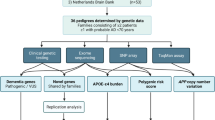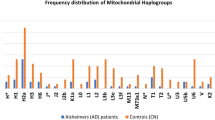Abstract
Association of the candidate gene DLST with late-onset Alzheimer's disease (LOAD) risk has been suggested on the basis of case-control studies. This gene, located on chromosome 24q24.3, encodes a subunit of a mitochondrial component known to be defective in AD, the α-ketoglutarate dehydrogenase complex. Positive reports have correlated different DLST alleles with LOAD, whereas other groups have failed to find any significant association. We therefore reexamined the association of DLST and LOAD in a more ethnically homogeneous series using three additional single nucleotide polymorphisms (SNP) located within or closely flanking either end of the DLST gene. Pairwise analysis of these SNPs indicated there was strong linkage disequilibrium across the DLST locus. Analysis of complex genotypes or haplotypes based upon all five SNP loci failed to identify a LOAD risk allele, suggesting that further studies of DLST in relation to AD are not warranted.
Similar content being viewed by others
References
Gibson, G. E., Sheu, K. F., Blass, J. P., Baker, A., Carlson, K. C., Harding, B., and Perrino, P. 1988. Reduced activities of thiamine-dependent enzymes in the brains and peripheral tissues of patients with Alzheimer's disease. Arch. Neurol. 45:836–840.
Mastrogiacoma, F., Lindsay, J. G., Bettendorff, L., Rice, J., and Kish, S. J. 1996. Brain protein and alpha-ketoglutarate dehydrogenase complex activity in Alzheimer's disease. Ann. Neurol. 39:592–598.
Gibson, G. E., Haroutunian, V., Zhang, H., Park, L. C., Shi, Q., Lesser, M., Mohs, R. C., Sheu, R. K., and Blass, J. P. 2000. Mitochondrial damage in Alzheimer's disease varies with apolipoprotein E genotype. Ann. Neurol. 48: 297–303.
Nakano, K., Ohta, S., Nishimaki, K., Miki, T., and Matuda, S. 1997. Alzheimer's disease and DLST genotype. Lancet 350:1367–1368.
Ma, Q., Chan, P., and Yang, J. 2001. [Association between DLST gene polymorphism and Alzheimer's disease]. Zhonghua Yi Xue Za Zhi. 81:1246–1248.
Kobayashi, T., Matsumine, H., Matuda, S., and Mizuno, Y. 1998. Association between the gene encoding the E2 subunit of the alpha-ketoglutarate dehydrogenase complex and Parkinson's disease. Ann. Neurol. 43:120–123.
Sheu, K. F., Brown, A. M., Haroutunian, V., Kristal, B. S., Thaler, H., Lesser, M., Kalaria, R. N., Relkin, N. R., Mohs, R. C., Lilius, L., Lannfelt, L., and Blass, J. R. 1999. Modulation by DLST of the genetic risk of Alzheimer's disease in a very elderly population. Ann. Neurol. 45:48–53.
Sheu, K. F., Brown, A. M., Kristal, B. S., Kalaria, R. N., Lilius, L., Lannfelt, L., and Blass, J. P. 1999. A DLST genotype associated with reduced risk for Alzheimer's disease. Neurology 52:1505–1507.
Kunugi, H., Nanko, S., Ueki, A., Isse, K., and Hirasawa, H. 1998. DLST gene and Alzheimer's disease. Lancet 351:1584–1585.
Matsushita, S., Arai, H., Yuzuriha, T., Kato, M., Matsui, T., Urakami, K., and Higuchi, S. 2001. No association between DLST gene and Alzheimer's disease or Wernicke-Korsakoff syndrome. Neurobiol. Aging 22:569–574.
Prince, J. A., Feuk, L., Sawyer, S. L., Gottfries, J., Ricksten, A., Nagga, K., Bogdanovic, N., Blennow, K., and Brookes, A. J. 2001. Lack of replication of association findings in complex disease: An analysis of 15 polymorphisms in prior candidate genes for sporadic Alzheimer's disease. Eur. J. Hum. Genet. 9:437–444.
Haroutunian, V., Perl, D. P., Purohit, D. P., Marin, D., Khan, K., Lantz, M., Davis, K. L., and Mohs, R. C. 1998. Regional distribution of neuritic plaques in the nondemented elderly and subjects with very mild Alzheimer disease. Arch. Neurol. 55:1185–1191.
Morris, J. C., Ernesto, C., Schafer, K., Coats, M., Leon, S., Sano, M., Thal, L. J., and Woodbury, P. 1997. Clinical dementia rating training and reliability in multicenter studies: The Alzheimer's Disease Cooperative Study experience. Neurology 48:1508–1510.
Moraes, C. T., Shanske, S., Tritschler, H. J., Aprille, J. R., Andreetta, F., Bonilla, E., Schon, E. A., and DiMauro, S. 1991. mtDNA depletion with variable tissue expression: A novel genetic abnormality in mitochondrial diseases. Am. J. Hum. Genet. 48:492–501.
Wallace, D. C., Stugard, C., Murdock, D., Schurr, T., and Brown, M. D. 1997. Ancient mtDNA sequences in the human nuclear genome: A potential source of errors in identifying pathogenic mutations. Proc. Natl. Acad. Sci. USA 94:14900–14905.
Hirano, M., Shtilbans, A., Mayeux, R., Davidson, M. M., DiMauro, S., Knowles, J. A., and Schon, E. A. 1997. Apparent mtDNA heteroplasmy in Alzheimer's disease patients and in normals due to PCR amplification of nucleus-embedded mtDNA pseudogenes. Proc. Natl. Acad. Sci. USA 94:14894–14899.
Guo, S. W. and Thompson, E. A. 1992. Performing the exact test of Hardy-Weinberg proportion for multiple alleles. Biometrics 48:361–372.
Zaykin, D., Zhivotovsky, L., and Weir, B. S. 1995. Exact tests for association between alleles at arbitrary numbers of loci. Genetica 96:169–178.
Ott, J. 1999. Analysis of Human Genetic Linkage, The Johns Hopkins University Press, Baltimore, Md.
Gordon, D., Simonic, I., and Ott, J. 2000. Significant evidence for linkage disequilibrium over a 5-cM region among Afrikaners. Genomics 66:87–92.
Terwilliger, J. D. and Ott, J. 1994, Handbook of Human Genetic Linkage, Johns Hopkins, Baltimore, Md.
Schaid, D. J. and Jacobsen, S. J. 1999. Biased tests of association: Comparisons of allele frequencies when departing from Hardy-Weinberg proportions [comment]. Am. J. Epidemiol. 149:706–711.
Single, R. M., Meyer, D., Hollenbach, J. A., Nelson, M. P., Noble, J. A., Erlich, H. A., and Thomson, G. 2002. Haplotype frequency estimation in patient populations: The effect of departures from Hardy-Weinberg proportions and collapsing over a locus in the HLA region. Genet. Epidemiol. 22:186–195.
Zhao, J. H., Curtis, D., and Sham, P. C. 2000. Model-free analysis and permutation tests for allelic associations. Hum. Hered. 50:133–139.
Sasieni, P. D. 1997. From genotypes to genes: Doubling the sample size. Biometrics 53:1253–1261.
Agresti, A. 2002, Categorical data analysis. Page 710, in Wiley Series in Probability and Statistics, John Wiley and Sons, Hoboken, NJ.
Akaike, H. 1973, Information theory and an extension of the maximum likelihood principle. Pages 267–281, in Petrov, B. N. and Csaki, F. (eds.), 2nd International Symposium on Information Theory Akademia Kiado, Budapest.
Cochran, W. G. 1952. The chi-square test of goodness of fit. Ann. Math. Stat. 23:315–345.
Lewontin, R. C. 1964. The interaction of selection and linkage: I. General considerations: Heterotic models. Genetics 49:49–67.
Corder, E. H., Saunders, A. M., Strittmatter, W. J., Schmechel, D. E., Gaskell, P. C., Small, G. W., Roses, A. D., Haines, J. L., and Pericak-Vance, M. A. 1993. Gene dose of apolipoprotein E type 4 allele and the risk of Alzheimer's disease in late onset families [comment]. Science 261:921–923.
Strittmatter, W. J., Saunders, A. M., Schmechel, D., Pericak-Vance, M., Enghild, J., Salvesen, G. S., and Roses, A. D. 1993. Apolipoprotein E: High-avidity binding to beta-amyloid and increased frequency of type 4 allele in late-onset familial Alzheimer disease. Proc. Nat. Acad. Sci. USA 90:1977–1981.
Shimokata, H., Yamada, Y., Nakagawa, M., Okubo, R., Saido, T., Funakoshi, A., Miyasaka, K., Ohta, S., Tsujimoto, G., Tanaka, M., Ando, F., and Niino, N. 2000. Distribution of geriatric disease-related genotypes in the National Institute for Longevity Sciences, Longitudinal Study of Aging (NILS-LSA). J. Epidemiol. 10:S46–S55.
Cruts, M., Backhovens, H., Van Gassen, G., Theuns, J., Wang, S. Y., Wehnert, A., van Duijn, C. M., Karlsson, T., Hofman, A., Adolfsson, R., and et al. 1995. Mutation analysis of the chromosome 14q24.3 dihydrolipoyl succinyltransferase (DLST) gene in patients with early-onset Alzheimer disease. Neurosci. Lett. 199:73–77.
Trikka, D., Fang, Z., Renwick, A., Jones, S. H., Chakraborty, R., Kimmel, M., and Nelson, D. L. 2002. Complex SNP-based haplotypes in three human helicases: Implications for cancer association studies. Genome Res. 12:627–639.
Fullerton, S. M., Clark, A. G., Weiss, K. M., Nickerson, D. A., Taylor, S. L., Stengard, J. H., Salomaa, V., Vartiainen, E., Perola, M., Boerwinkle, E., and Sing, C. E. 2000. Apolipoprotein E variation at the sequence haplotype level: Implications for the origin and maintenance of a major human polymorphism. Am. J. Hum. Genet. 67:881–900.
Schellenberg, G. D., D'Souza, I., and Poorkaj, P. 2000. The genetics of Alzheimer's disease. Curr. Psychiatry Rep. 2:158–164.
Ward, C. P., Fensom, A. H., and Green, P. M. 2000. Biallelic discrimination assays for the three common Ashkenazi Jewish mutations and a common non-Jewish mutation, in Tay-Sachs disease, using fluorogenic TaqMan probes. Genet. Test. 4:351–358.
Bahar, A. Y., Taylor, P. J., Andrews, L., Proos, A., Burnett, L., Tucker, K., Friedlander, M., and Buckley, M. F. 2001. The frequency of founder mutations in the BRCA1, BRCA2, and APC genes in Australian Ashkenazi Jews: Implications for the generality of U.S. population data. Cancer 92:440–445.
Bassett, S. S., Avramopoulos, D., and Fallin, D. 2002. Evidence for parent of origin effect in late-onset Alzheimer disease. Am. J. Med. Genet. 114:679–686.
Brown, A. M., Gordon, D., Lee, H., Caudy, M., Hardy, J., Haroutunian, V., and Blass, J. P. 2004. Association of the dihydrolipoamide dehydrogenase gene with Alzheimer's disease in an Ashkenazi Jewish population. Am. J. Med. Genet. (in press).
Author information
Authors and Affiliations
Corresponding author
Rights and permissions
About this article
Cite this article
Brown, A.M., Gordon, D., Lee, H. et al. Substantial Linkage Disequilibrium Across the Dihydrolipoyl Succinyltransferase Gene Region Without Alzheimer's Disease Association. Neurochem Res 29, 629–635 (2004). https://doi.org/10.1023/B:NERE.0000014833.54481.1d
Issue Date:
DOI: https://doi.org/10.1023/B:NERE.0000014833.54481.1d




